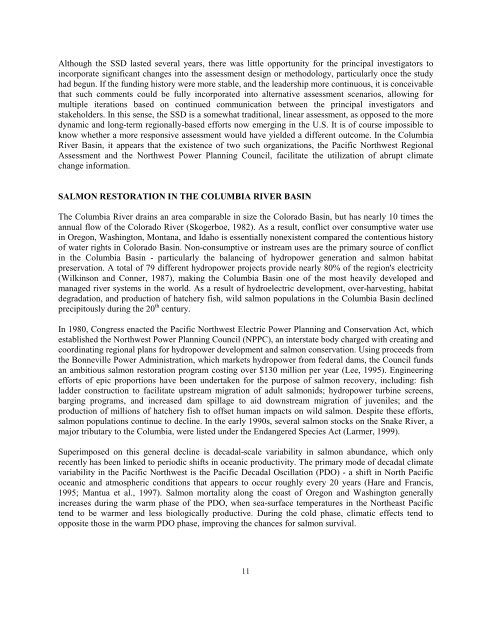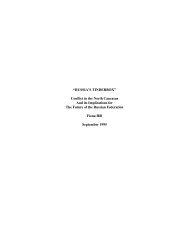Global Environmental Assessment Project - Belfer Center for ...
Global Environmental Assessment Project - Belfer Center for ...
Global Environmental Assessment Project - Belfer Center for ...
You also want an ePaper? Increase the reach of your titles
YUMPU automatically turns print PDFs into web optimized ePapers that Google loves.
Although the SSD lasted several years, there was little opportunity <strong>for</strong> the principal investigators to<br />
incorporate significant changes into the assessment design or methodology, particularly once the study<br />
had begun. If the funding history were more stable, and the leadership more continuous, it is conceivable<br />
that such comments could be fully incorporated into alternative assessment scenarios, allowing <strong>for</strong><br />
multiple iterations based on continued communication between the principal investigators and<br />
stakeholders. In this sense, the SSD is a somewhat traditional, linear assessment, as opposed to the more<br />
dynamic and long-term regionally-based ef<strong>for</strong>ts now emerging in the U.S. It is of course impossible to<br />
know whether a more responsive assessment would have yielded a different outcome. In the Columbia<br />
River Basin, it appears that the existence of two such organizations, the Pacific Northwest Regional<br />
<strong>Assessment</strong> and the Northwest Power Planning Council, facilitate the utilization of abrupt climate<br />
change in<strong>for</strong>mation.<br />
SALMON RESTORATION IN THE COLUMBIA RIVER BASIN<br />
The Columbia River drains an area comparable in size the Colorado Basin, but has nearly 10 times the<br />
annual flow of the Colorado River (Skogerboe, 1982). As a result, conflict over consumptive water use<br />
in Oregon, Washington, Montana, and Idaho is essentially nonexistent compared the contentious history<br />
of water rights in Colorado Basin. Non-consumptive or instream uses are the primary source of conflict<br />
in the Columbia Basin - particularly the balancing of hydropower generation and salmon habitat<br />
preservation. A total of 79 different hydropower projects provide nearly 80% of the region's electricity<br />
(Wilkinson and Conner, 1987), making the Columbia Basin one of the most heavily developed and<br />
managed river systems in the world. As a result of hydroelectric development, over-harvesting, habitat<br />
degradation, and production of hatchery fish, wild salmon populations in the Columbia Basin declined<br />
precipitously during the 20 th century.<br />
In 1980, Congress enacted the Pacific Northwest Electric Power Planning and Conservation Act, which<br />
established the Northwest Power Planning Council (NPPC), an interstate body charged with creating and<br />
coordinating regional plans <strong>for</strong> hydropower development and salmon conservation. Using proceeds from<br />
the Bonneville Power Administration, which markets hydropower from federal dams, the Council funds<br />
an ambitious salmon restoration program costing over $130 million per year (Lee, 1995). Engineering<br />
ef<strong>for</strong>ts of epic proportions have been undertaken <strong>for</strong> the purpose of salmon recovery, including: fish<br />
ladder construction to facilitate upstream migration of adult salmonids; hydropower turbine screens,<br />
barging programs, and increased dam spillage to aid downstream migration of juveniles; and the<br />
production of millions of hatchery fish to offset human impacts on wild salmon. Despite these ef<strong>for</strong>ts,<br />
salmon populations continue to decline. In the early 1990s, several salmon stocks on the Snake River, a<br />
major tributary to the Columbia, were listed under the Endangered Species Act (Larmer, 1999).<br />
Superimposed on this general decline is decadal-scale variability in salmon abundance, which only<br />
recently has been linked to periodic shifts in oceanic productivity. The primary mode of decadal climate<br />
variability in the Pacific Northwest is the Pacific Decadal Oscillation (PDO) - a shift in North Pacific<br />
oceanic and atmospheric conditions that appears to occur roughly every 20 years (Hare and Francis,<br />
1995; Mantua et al., 1997). Salmon mortality along the coast of Oregon and Washington generally<br />
increases during the warm phase of the PDO, when sea-surface temperatures in the Northeast Pacific<br />
tend to be warmer and less biologically productive. During the cold phase, climatic effects tend to<br />
opposite those in the warm PDO phase, improving the chances <strong>for</strong> salmon survival.<br />
11
















